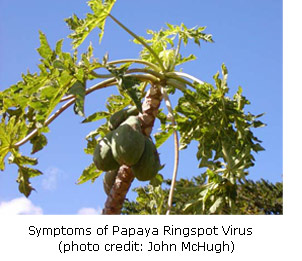Genetically Engineered Crops in Hawaii
 In Hawaii, we have about 100,000 acres available for diversified agriculture. Of this land, less than 3% is planted in genetically engineered crops. The primary GE crops grown are papaya, which is used for local consumption and export, and seed crops, which are used for crop development.
In Hawaii, we have about 100,000 acres available for diversified agriculture. Of this land, less than 3% is planted in genetically engineered crops. The primary GE crops grown are papaya, which is used for local consumption and export, and seed crops, which are used for crop development.
Hawaii has long been a favorite location for seed growers due to its unique year-round growing environment. Seed producers in Hawaii are busiest planting from October to January when many of the U.S. mainland’s seed-growing regions are snowy or too cold for plants to grow. Corn accounts for 96% (NASS, 2007) of the seed crop and is being grown in increasing amounts to meet the demand for ethanol and other corn based products. In Hawaii, about 60% of seed corn is GE, which is about 3500 acres. National statistics show that 80% of the corn grown in the United States is genetically engineered (USDA, 2008). The remaining seed crops are soybean, cotton, sunflower, wheat, and a few other crops. These crops include both classically bred and transgenic varieties.
 The papaya ringspot virus has been present in Hawaii since the 1940s. It was first discovered in Puna, the primary commercial growing district for papaya, in 1992. Within two years, it had spread throughout most of Puna and was decreasing fruit production. Researchers had already identified a gene for the virus protein coat and had shown that inserting this gene into the papaya DNA resulted in plants that were resistant to the virus. Scientists at CTAHR, Cornell University and the USDA were able to develop resistant papaya varieties based on this research. After being evaluated for health and environmental safety, the papaya received government approval, and seeds were made available in 1998. Interestingly, the use of GE papaya has also increased productivity of the non-GE varieties. Fields of GE papaya act as a buffer that stops the spread of the virus (Gonsalves, 2004).
The papaya ringspot virus has been present in Hawaii since the 1940s. It was first discovered in Puna, the primary commercial growing district for papaya, in 1992. Within two years, it had spread throughout most of Puna and was decreasing fruit production. Researchers had already identified a gene for the virus protein coat and had shown that inserting this gene into the papaya DNA resulted in plants that were resistant to the virus. Scientists at CTAHR, Cornell University and the USDA were able to develop resistant papaya varieties based on this research. After being evaluated for health and environmental safety, the papaya received government approval, and seeds were made available in 1998. Interestingly, the use of GE papaya has also increased productivity of the non-GE varieties. Fields of GE papaya act as a buffer that stops the spread of the virus (Gonsalves, 2004).

